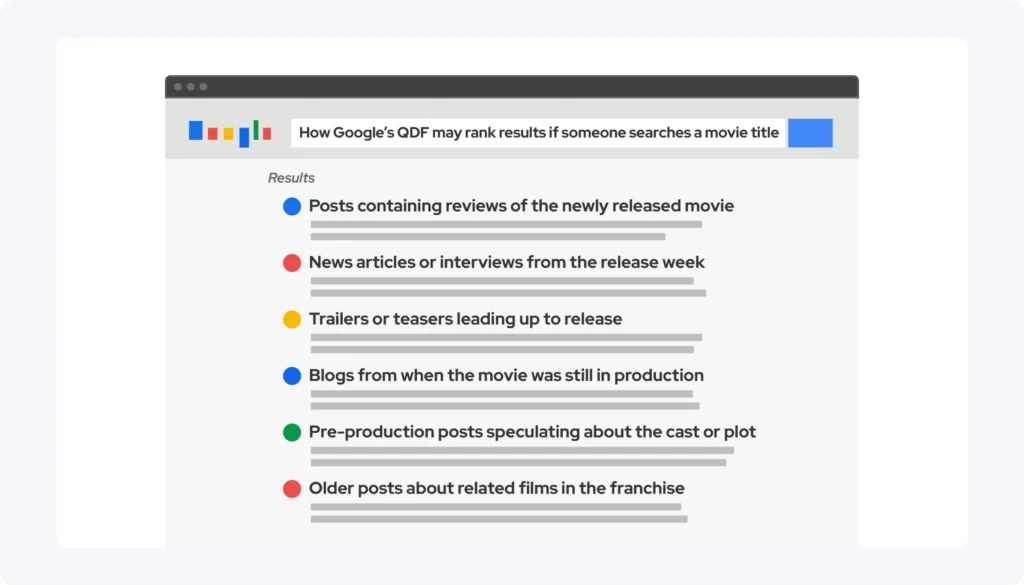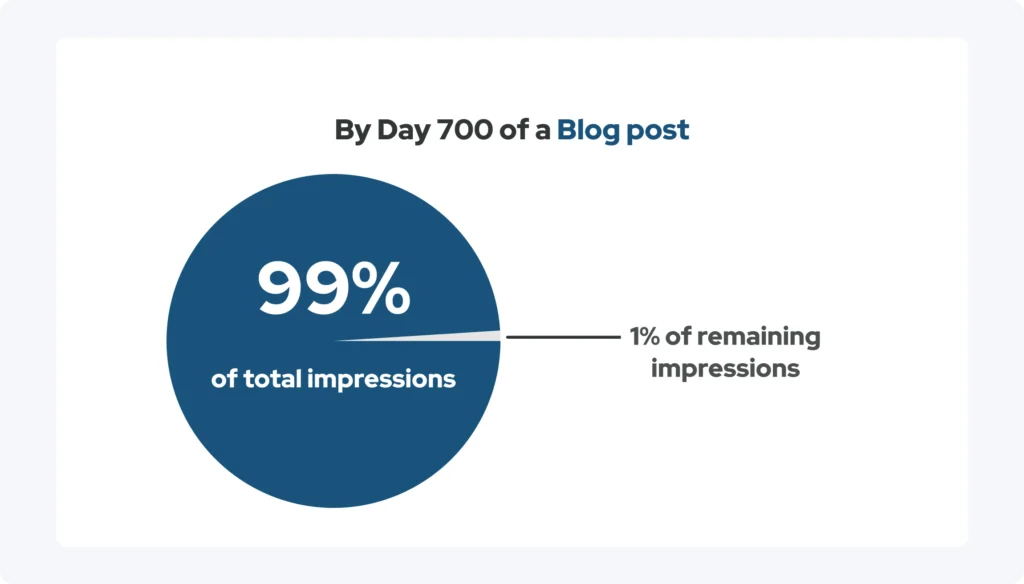Executive Summary
- Both search engines and readers favor time-relevant content with accurate, up-to-date information, so keeping a blog evergreen can extend its reach and improve a brand’s return on investment (ROI).
- You can prioritize content relevance by writing about evergreen topics, consistently updating old blogs, and repurposing content into different formats like social media posts or video scripts.
- Re-promote old blogs and link them within newer content to consistently draw readers in, even if search engines are no longer prioritizing those old posts.
- A professional content team can help you boost blog performance by routinely updating content to meet SEO trends, increase readability, and ensure claims are backed by new, reliable research.
Understanding Why Blog Longevity Matters
Blogs with valuable, search-friendly content can be helpful tools for brands by boosting visibility, fostering trust, and driving traffic. However, without the right strategies in place, many organizations invest time and resources into blog content only to watch their posts quickly fade from significance and lose their value.
This is because search engines and readers favor fresh, accurate content that aligns with their search query. For example, when ranking search results, the Google algorithm’s “Query Deserves Freshness” (QDF) systems prioritize newer, recently-updated, or evergreen content. That means outdated blogs, even previously high-performing ones, may slip from the top of search results if they do not prioritize content relevance.
With a few tips and tricks, a blog can be more than just a brief traffic spike; it can be a long-term marketing asset that stays relevant and valuable long after publishing. The guide below can equip you with evergreen content ideas and strategies for refreshing existing posts to help them regain visibility and drive sustained traffic.

Five Ways to Keep Your Content Working for You
Research shows the average lifespan of a blog post is approximately two years. However, following the five strategies below can help your content stay relevant and drive traffic for even longer.

1. Prioritize Evergreen Topics
Creating content that stands the test of time starts with selecting the right topics. You should write about subjects that offer long-term value and are less likely to become obsolete. Some of the best practices for choosing evergreen topics are:
- Answering recurring industry questions your audience repeatedly asks
- Focusing on foundational skills, strategies, or principles
- Avoiding topics that are heavily tied to trends or rapidly changing technology
Sometimes, you can extend content relevance merely through the verbiage you use. The table below illustrates different ways topics can be framed to achieve longevity.
| Time-Sensitive Topic | Evergreen Equivalent |
| 2025 SEO Trends for Content Strategy | How to Build an SEO Content Strategy |
| Email Marketing Strategies After Gmail’s Updates | Best Practices for Email Marketing |
| Google’s Latest Core Web Vitals Update | How to Improve Website UX |
| Instagram Engagement Tactics for 2025 | Social Media Marketing Fundamentals |
If you decide to write news-driven or trend-specific content, be prepared to revisit and update it consistently to keep it performing as well as possible. For example, by changing the year and updating any important information, you can repurpose that “2024” blog into a “2025” blog that still performs and keeps up with the trends year after year.
2. Refresh and Update Older Content
You do not always have to create an entirely new blog to get more traffic to your site—simply updating existing blogs can lead to as much as a 106% increase in organic traffic. You should focus on revamping long-term content with new data, improved formatting, and modern SEO strategies to boost rankings and reignite interest.
Start by browsing through your site’s blog and Google Analytics to identify posts that still bring in traffic but contain outdated information and posts ranking below competitors for key terms. Then, some essential elements you should update include:
- Outdated statistics and facts should reflect industry changes
- Old case studies should be swapped with newer ones
- Keywords and SEO strategies should align with current trends
- Broken or outdated links should be fixed or removed
- CTAs tied to expired offers or irrelevant events should be erased
- Large content blurbs should be formatted for readability by shortening paragraphs, adding subheadings, and relying on bullets
Once refreshed, you can republish the blog with an updated date and resubmit it to Google to trigger reindexing to tell the search engine that your content is current and valuable.
3. Repurpose Blog Content into Different Formats
Content repurposing is the process of taking key points from a blog and transforming them into multiple assets for different channels. It’s an effective way to spread the core messages of a blog while meeting your audience where they are.
Some common examples of content repurposing are:
- Paraphrasing a blog and turning it into a new LinkedIn post
- Converting a blog into a script for a video or webinar segment
- Incorporating a blog’s most key takeaways into a Pinterest infographic
- Extracting actionable tips from a blog and adding them to a downloadable checklist that is sent via email
By revisiting your top-performing blogs and brainstorming how each one could be repackaged to keep delivering value, you can improve brand visibility across multiple platforms and increase the return on investment (ROI) from a single piece of content. Depending on how you repackage the blog, this approach may also help reach audiences who prefer visual or audio content over reading; making content accessible for people with various learning styles is crucial to digital marketing.
4. Optimize Internal Linking for Long-Term Traffic
Think of your site’s content as a city, with each post represented as a building. Using internal links, you can build roads from new popular buildings to old ones that are still worth visiting. In other words, linking old yet relevant content in your new blogs can help keep those older posts visible and valuable, strengthen topical authority in your niche, and motivate readers to stay on your site longer.
Some of the best practices for internal linking to keep content evergreen are:
- Use detailed anchor text with SEO value in lieu of vague terms like “click here”
- Only link to relevant content that was once high-performing
- Avoid putting too many links in a single post to preserve your reader’s focus
- Ensure all linked pages are live, updated, and user-friendly
You should use tools like Google Search Console to identify which older posts are underperforming and could get SEO benefits from being linked within newer blogs. Still, internal linking isn’t just for SEO; it can enhance user experience by helping readers discover more valuable content that applies to their query.
5. Promote Old Content Like It’s New
Many organizations only promote blog posts shortly after they are made and then never again, allowing traffic to fall drastically. To keep a steady flow of impressions, you should reshare old blogs whenever they become relevant again. For instance, if your blog offers tax tips, it may be worth re-promoting every tax season.
Some examples of ways to reintroduce older posts include:
- Scheduling periodic social media reposts
- Including links in email newsletters under sections like “related reading”
- Refreshing titles and meta descriptions based on trending search terms
- Bundling in roundup posts like “Top 5 Content Strategy Blogs”
- Partnering with influencers and asking them to share aged but useful content
Many people report seeing the best SEO results when they strengthen and update a once-popular piece of content and then re-promote the blog through email, social media, and paid traffic. High-quality content has no expiration date, so you should keep sharing it.
How Professional Content Writers Can Help
Ensuring content is regularly updated and optimized can take a lot of time, effort, and SEO knowledge. Using a dependable, experienced content writing agency can ease this burden and ensure content is evergreen and stays relevant to its readers. Some things an experienced content team can help with are:
- Identifying potential for high-impact, rank-boosting updates
- Repurposing content while maintaining brand voice
- Adding up-to-date SEO tactics to older posts
- Maintaining a content refresh schedule that prevents stagnation
If you’re investing in content, don’t let it expire sooner than it has to. Bring in a strategic, consistent team that keeps your blogs working for your brand; it is an investment that is bound to pay off. Research shows that per dollar spent, content marketing generates 3x more leads than traditional marketing, making it well worth your time and budget.
Get Long-Lasting Value From Your Content with collystring
Following strategies like selecting evergreen content ideas as the foundation of new pieces and repurposing old blogs into different content formats can help you get the most out of every post and guarantee content relevance for years to come. With a seasoned content creation partner, you don’t have to take this on alone.
At collystring, we understand that keeping content fresh is a full-time job—one that we are built for. Our expert team will function as an extension of your organization, handling blogs and other marketing strategies from start to finish. So if your current content feels like it’s losing steam or not giving you the best ROI possible, we can help maximize your content’s value, improve SEO rankings, and keep blogs driving traffic and conversions for as long as possible.
Reach out to collystring to make your content work harder and last longer.
